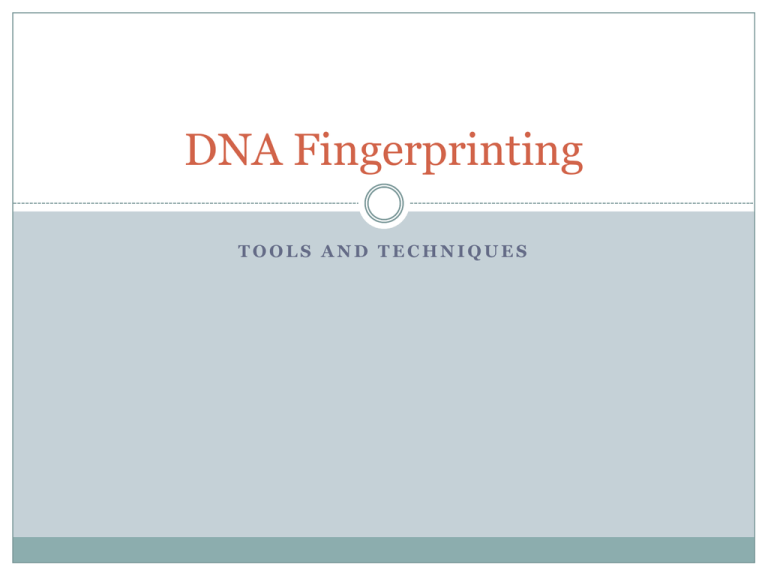DNA Fingerprinting
advertisement

DNA Fingerprinting TOOLS AND TECHNIQUES Intoducing the microLiter! A TINY amount…a millionth of a Liter Very difficult to measure because it is SOOO small Incredibly accurate when measured correctly Tools that measure these amounts are therefore INCREDIBLY expensive…be VERY careful with them!!! If a milliliter (mL) is 1/1000 of a Liter… A microliter (μl) is 1/1000 of a millileter (mL) The greek letter “mu” is used to represent micro (μ) Let’s PRACTICE Work through the second page of the packet “DNA Fingerprinting – Practice Worksheet” The TOOLS DNA Fingerprinting makes use of tools that can work with incredibly SMALL volumes We only need a very small sample of DNA We can run hundreds or thousands of samples at once in small spaces We can be INCREDIBLY accurate and precise We can use robotic assistance to run the full analysis The Micropipette Are like a normal pipette…but better They can hold incredibly small amounts of liquid with incredibly high accuracy and precision This makes them VERY expensive!!! Two types that we will use: P20: Can hold up to 20 μl P200: Can hold up to 200 μl Draw and label a picture to refer back to: Setting the Micropipette Each micropipette has a dial for its particular volume maximum NEVER set the dial above the MAXIMUM listed, this will damage the micropipette For a p20…NEVER set above 20 The three numbers represent the three place values Starting with the largest POSSIBLE place value Let’s PRACTICE with the second half of practice worksheet Techniques for Using Tips NEVER TILT THE PIPETTE!!! NEVER USE A NAKED PIPETTE!!! We use tips to hold liquid, not the pipette itself Liquids can actually damage (very severely) the internal parts To pick up a tip, push the pipette into the tip holder ALWAYS keep the tip box COVERED This keeps out contaminants After using ANY liquid, we will switch tips This will also help minimize the risk of contamination through mixing of samples To eject a tip, push down on the SIDE button This is attached to the metal rod that will push down on the tip Always eject tips into a WASTE BIN Techniques for using a Micropipette Push the PLUNGER to the FIRST Stop DO NOT GO FURTHER THAN THE FIRST STOP We must create a vacuum in order to pick up liquid While holding it down, insert the tip into your liquid DO NOT LET GO UNTIL YOU ARE IN LIQUID This will pick up air, not the liquid Release the plunger to pick up the liquid To eject, move the tip into the desired container Hold the tip against the inside surface of the container you wish to eject into Push the PLUNGER to the SECOND Stop to eject ALL liquid Let’s practice! Get a pipette each and practice picking up and ejecting a tip, and pushing the plunger to the FIRST and SECOND stop Using the microcentrifuge NEVER LOAD IT SIDEWAYS Like a washing/drying machine, it will spin out of control and potentially break ALWAYS balance the load In a 6-holder, this means you can load… NOT One Two Three Four NOT Five Six Balance the epitubes in the rotor Let’s practice!!! Do activity One and Two on the second instructional handout Answer the first two questions by converting Answer questions 3 and 4: the “Lab Observations” We will discuss and answer remaining questions after returning from break QoD: Final DNA Fingerprinting Day Summarize in a few brief sentences what we have done in this multi-day lab. Use and define the following terms: DNA (mother, baby, suspected father) Restriction Enzyme (HindIII) Agar gel Comb and wells Loading dye (indigo) Gel chamber and buffer Gel electrophoresis DNA Fingerprinting DAY ONE: CUTTING DNA WITH RESTRICTION ENZYME DAY TWO: CASTING GEL ADD LOADING DYE LOADING DNA RUNNING ELECTROPHORESIS DNA Fingerprinting: Day One We use a restriction enzyme to cut open our DNA samples Restriction enzymes are derived from bacteria, and named after them (EcoRI is from E. coli bacteria) They work like crooked scissors: cut sideways DNA pieces are run through gel electrophoresis, and spread out based on size. DNA starts at the negative end and runs towards the positive. Negative: Black Positive: Red We can use the lines of DNA to identify individuals by their DNA fingerprint. DNA Fingerprinting: Day Two We added a loading dye to run ahead of and behind the DNA. Since you can’t see DNA in gel electrophoresis, this helps show how far it has run. We loaded the DNA into gel wells and ran through the chamber for 30-50 minutes Buffer solution helps conduct electricity DNA is pulled from BLACK (negative) to RED (positive) end We are then left with lines of DNA of specific sizes, measured in kbp (Kilobase pairs) The DNA fragments are pushed with electricity to spread them out. This creates a DNA fingerprint






